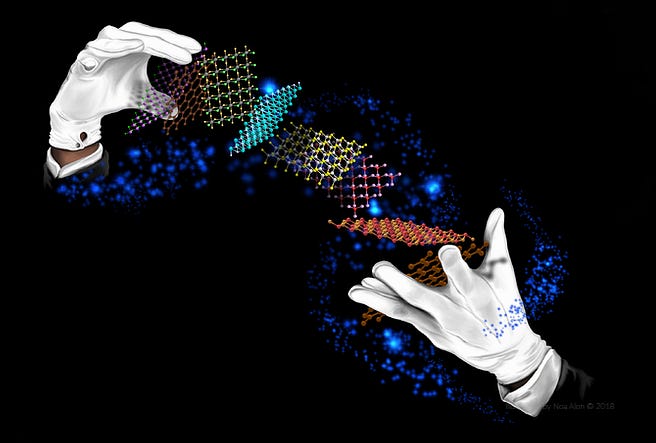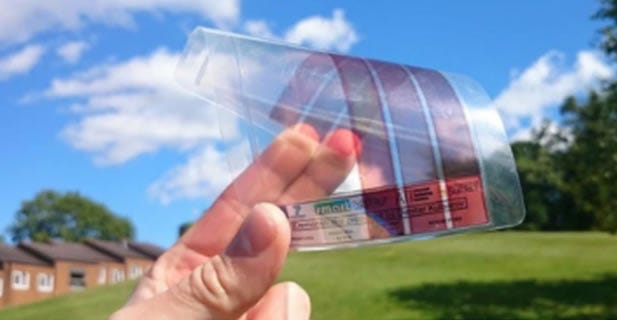Graphene (Part II)
New revolution in nanotechnological materials. Applications
If you would like to know more about graphene, I recommend you to visit my other newsletter dedicated exclusively to this material - https://graphene.substack.com/
In this second Graphene newsletter we will look at the different applications of this nanomaterial.
Graphene uses and applications
Energy storage and solar cells
Graphene-based nanomaterials have many promising applications in energy-related areas. Just some recent examples: Graphene improves both energy capacity and charge rate in rechargeable batteries; activated graphene makes superior supercapacitors for energy storage; graphene electrodes may lead to a promising approach for making solar cells that are inexpensive, lightweight and flexible; and multifunctional graphene mats are promising substrates for catalytic systems.
Researchers also have discovered a critical and unexpected relationship between the graphene's chemical/structural defectiveness as a host material for electrodes and its ability to suppress the growth of dendrites – branch-like filament deposits on the electrodes that can penetrate the barrier between the two halves of the battery and potentially cause electrical shorts, overheating and fires ("Defect-free graphene might solve lithium-metal batteries' dendrite problem").
These examples highlight the four major energy-related areas where graphene will have an impact: solar cells, supercapacitors, graphene batteries, and catalysis for fuel cells.
Due to their excellent electron-transport properties and extremely high carrier mobility, graphene and other other direct bandgap monolayer materials such as transition-metal dichalcogenides (TMDCs) and black phosphorus show great potential to be used for low-cost, flexible, and highly efficient photovoltaic devices. They are the most promising materials for advanced solar cells.
Sensor applications
Image Courtesy: ICS-8/Forschungszentrum Jülich and Leiden Institute of Chemistry/Leiden University
Functionalized graphene holds exceptional promise for biological and chemical sensors. Already, researchers have shown that the distinctive 2D structure of graphene oxide (GO), combined with its superpermeability to water molecules, leads to sensing devices with an unprecedented speed ("Ultrafast graphene sensor monitors your breath while you speak").
Scientists have found that chemical vapors change the noise spectra of graphene transistors, allowing them to perform selective gas sensing for many vapors with a single device made of pristine graphene – no functionalization of the graphene surface required ("Selective gas sensing with pristine graphene").
Quite a cool approach is to interface passive, wireless graphene nanosensors onto biomaterials via silk bioresorption as demonstrated by a graphene nanosensor tattoo on teeth monitors bacteria in your mouth.
Graphene ink
Graphene has a unique combination of properties that is ideal for next-generation electronics, including mechanical flexibility, high electrical conductivity, and chemical stability. Numerous research efforts already have demonstrated the feasibility of fabricating graphene-based electronics through high-throughput ink printing strategies. Formulating inkjet-printable graphene ink leads to an inexpensive and scalable path for exploiting graphene's properties in real-world technologies (read more here: "Inkjet printing of graphene for flexible electronics" and here: "Direct writing with highly conductive graphene inks").
Transistors and memory
Image Courtesy: Tunnelling transistor based on vertical graphene heterostructures (credit: L. Britnel et al./Science)
Some of the most promising applications of graphene are in electronics (as transistors and interconnects), detectors (as sensor elements) and thermal management (as lateral heat spreaders). The first graphene field-effect transistors (FETs) – with both bottom and top gates – have already been demonstrated. At the same time, for any transistor to be useful for analog communication or digital applications, the level of the electronic low-frequency noise has to be decreased to an acceptable level ("Graphene transistors can work without much noise").
Transistors on the basis of graphene are considered to be potential successors for the some silicon components currently in use. Due to the fact that an electron can move faster through graphene than through silicon, the material shows potential to enable terahertz computing.
In the ultimate nanoscale transistor – dubbed a ballistic transistor – the electrons avoid collisions, i.e. there is a virtually unimpeded flow of current. Ballistic conduction would enable incredibly fast switching devices. Graphene has the potential to enable ballistic transistors at room temperature.
While graphene has the potential to revolutionize electronics and replace the currently used silicon materials ("High-performance graphene transistor with high room-temperature mobility"), it does have an Achilles heel: pristine graphene is semi-metallic and lacks the necessary band gap to serve as a transistor. Therefore it is necessary to engineer band gaps in graphene.
Flexible, stretchable and foldable electronics
Flexible electronics relies on bendable substrates and truly foldable electronics requires a foldable substrate with a very stable conductor that can withstand folding (i.e. an edge in the substrate at the point of the fold, which develops creases, and the deformation remains even after unfolding).
That means that, in addition to a foldable substrate like paper, the conductor that is deposited on this substrate also needs to be foldable. To that end, researchers have demonstrated a fabrication process for foldable graphene circuits based on paper substrates.
Photodetectors
Imagen Courtesy: The photodetector operates across a broad range of light, processes images more quickly, and is more sensitive to low levels of light than current technology. Courtesy of UCLA Engineering.
Researchers have demonstrated that graphene can be used for telecommunications applications and that its weak and universal optical response might be turned into advantages for ultrafast photonics applications. They also found that graphene could be potentially exploited as a saturable absorber with wide optical response ranging from ultra-violet, visible, infrared to terahertz ("The rise of graphene in ultra-fast photonics").
Coatings
Coating objects with graphene can serve different purposes. For instance, researchers have now shown that it is possible to use graphene sheets to create a superhydrophobic coating material that shows stable superhydrophobicity under both static as well as dynamic (droplet impact) conditions, thereby forming extremely water repelling structures.
Graphene also is the world's thinnest known coating for protecting metals against corrosion. It was found that graphene, whether made directly on copper or nickel or transferred onto another metal, provides protection against corrosion.
Researchers demonstrated the use of graphene as a transparent conductive coating for photonic devices and show that its high transparency and low resistivity make this two-dimensional crystal ideally suitable for electrodes in liquid crystal devices (LCDs).
Other uses: Loudspeakers, Biotechnology and medicine, Radiation shielding, Thermal management, Cloaking, Lubrication, Water purification, Face masks...
Don't hesitate to subscribe if you haven't already done so.
Regards and take care.
Born in 2012, Scixel is a project devoted to the improvement of the scientific comunication through the creation of graphical products: pictures, animations, graphs, posters, etc. Scixel consists of scientists with a deep knowledge in digital graphics but also with a long experience in giving talks, preparing posters and papers and other daily situations of scientific work.
We have focused our work into universities and research institutes all over the world: TuDelft (The Netherlands), NIMS (Japan), Basel University (Switzerland), Universidad Autónoma de Madrid, CNB or ICFO (Spain), to name a few.
Web: https://scixel.es/
If you are a company or an individual who would like to place your advertising in my newsletter you can contact me (email) and let me know your request of type of ad and number of newsletters you would like to place it. I will send you a budget as soon as possible.











